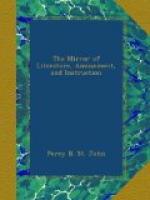Mr. Hone observes, in his work on “Ancient Mysteries,” that “the custom of singing carols at Christmas prevails in Ireland to the present time. In Scotland, where no church fasts have been kept since the days of John Knox, the custom is unknown. In Wales it is still preserved to a greater extent, perhaps, than in England: at a former period, the Welsh had carols adapted to most of the ecclesiastical festivals, and the four seasons of the year; but at this time they are limited to that of Christmas. After the turn of midnight, on Christmas-eve, service is performed in the churches, followed by singing carols to the harp. Whilst the Christmas holidays continue, they are sung in like manner in the houses; and there are carols especially adapted to be sung at the doors of the houses by visitors before they enter. Lffyr Carolan, or the Book of Carols, contains sixty-six for Christmas, and five summer carols. Blodengerdd Cymrii, or the Anthology of Wales, contains forty-eight Christmas carols, nine summer carols, three May carols, one winter carol, one nightingale carol, and a carol to Cupid. On the Continent, the custom of carolling at Christmas is almost universal. During the last days of Advent, Calabrian minstrels enter Rome, and are to be seen in every street, saluting the shrines of the Virgin mother with their wild music, under the traditional notion of charming her labour pains on the approaching Christmas.”
Why do the Christmas carols of the present day differ from the carols of earlier times?
Because the present carols were substituted, by those enemies of innocent mirth, the Puritans, for the original carols, which were festal chansons for enlivening the merriment of the Christmas celebrity; and not such religious songs as are current at this day, with the common people, under the same title.
Dr. Johnson, in a note on Hamlet, tells us, that the pious chansons, a kind of Christmas carol, containing some Scripture history, thrown into loose rhymes, were sung about the streets by the common people, when they went at that season to beg alms.—Brand.
Why is laurel used with other evergreens to deck houses at Christmas?
Because of its use among the ancient Romans, as the emblem of peace, joy, and victory. In the Christian sense, it may be applied to the victory gained over the powers of darkness by the coming of Christ.—Bourne.
Why is the mistletoe so called?
Because its seeds are said to be dropped by the mistle-thrush, which feeds on its berries.
Why was the mistletoe held sacred by the Druids?
Because they had an extraordinary reverence for the number three, and not only the berries, but the leaves of the mistletoe, grow in clusters of three united on one stalk. Its growing upon the oak, their sacred tree, was doubtless another cause of its veneration.




